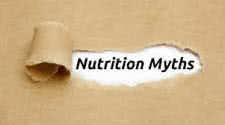Fact vs. Fiction - Common Nutrition Misconceptions

Join us as we bust through common myths when it comes to nutrition..
Fiction: Megadoses of vitamin C can help correct skin disorders like acne, prevent bruising and mend varicose veins.
Fact: Although a steady excess of iodine in the diet can cause acne, no food or nutrient is known to cure it. As for
the bruising truth about vitamin C, otherwise known as ascorbic acid, because it strengthens cell walls, a deficiency can make you prone to bruising;
however, taking excessive doses won't make you bruise proof.
The tendency to develop varicose veins is usually inherited, and so they're not generally recognized as a symptom of poor nutrition. Once they
surface, though, no amount of vitamin C can erase them.
Even so, as the largest organ of the human body the skin is often the chalkboard of our nutritional needs. According to experts at the University of
California at Berkeley, a deficiency of B-vitamins or an excess of vitamin A, which can occur when you take beta carotene, can cause skin to scale and
develop dermatitis, and too little protein can promote extreme dryness and cracking.
To dispel another myth, gelatin supplements won't make your fingernails grow. Gelatin is an incomplete protein that lacks too many amino acids to be
of any help in producing keratin, the chief ingredient in the formation of fingernails.
Fiction: Ground beef that's labeled "extra lean" is much leaner than the "lean" grade and significantly leaner than the
regular grade.
Fact: Bright red hamburger that's, labeled "lean" or "extra lean" can variety has retained its bran-germ husk and, therefore, contains about three
times more fiber, some trace nutrients and a tad more fat. Although white rice is often enriched with B-vitamins and iron, these can be lost during
rinsing. Even so, according to experts at U.C. Berkeley, "White and brown rice are not significantly different when it comes to nutrition....Unless
you eat several cups of it a day, brown rice is not a significant source of fiber."
Fiction: If there are white lumps in egg whites, it means that the egg is old.
Fact: There's a name for those white twisted strands found in egg albumen-chalazae. Chalazae keep the yolk anchored in the
center of the white. Contrary to myth, the thicker the chalazae, the fresher the egg.
Fiction: Simple Pleasures, the new fake-fat frozen dessert that comes in a variety of flavors, contains fewer calories than
other frozen desserts-including frozen yogurt.
Fact: Not hardly. Simple Pleasures may lack fat, but due to its high sugar content it contains more calories than most brands
of frozen yogurt, ice milk and sorbet-and almost as much as regular ice cream. The newly approved non dairy dessert, Mellorine, which replaces milk fat
with other fats, contains even more calories, as shown in Figure 1. Still, both products feature about half the calories of Haagen-Dazs ice cream.
It's also important to note that sherbet and sorbet are two different items; sherbet is blended with milk solids, and sorbet is composed of fruit, fruit
juices, sweetener and water. In any case, most low- or non-fat frozen desserts will freeze harder but melt quickly in your mouth.